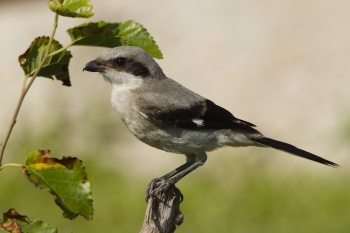- Lanius ludovicianus
Identification
Length 9 inches (18-22 cm), weight 43-54 g
Gray head and back, white under parts, broad black face mask extending narrowly across above the bill, black bill. Wings and tail black with white flash at base of primaries; scapulars gray with white tips (white varying in width between different subspecies). Juvenile finely barred.
Similar species
Northern Shrike differs in being slightly larger and longer-tailed, and with the black mask never extending onto the forehead.
Distribution
North America (north to south-central Canada) and Mexico. Populations in south, west, and east USA resident, those in north-central USA and Canada migrate a short way south in winter. Canadian and eastern populations declining; no longer breeding in the northeast US, where now a scarce passage visitor.
Taxonomy
Subspecies
Eleven subspecies are recognized[1]:
- L. l. gambeli: Western North America (south-western Canada to south-western US); winters to western Mexico
- L. l. excubitorides: Great Plains region of North America; winters to southern Mexico
- L. l. migrans: Eastern North America (south-eastern Canada to eastern Texas); winters to north-eastern Mexico
- L. l. sonoriensis: Arid south-western US to north-western Mexico (northern Durango and southern Sinaloa)
- L. l. anthonyi: Northern Channel Islands (off southern California)
- L. l. mearnsi: San Clemente Island (off southern California). ±13 birds in wild 1999
- L. l. grinnelli: Southern California (San Diego County) and northern Baja California
- L. l. nelsoni: Southern Baja California
- L. l. ludovicianus: Coastal south-eastern US (Virginia to Florida)
- L. l. miamensis: Southern Florida
- L. l. mexicanus: Central Mexico (southern Tamaulipas and Nayarit to Oaxaca)
The subspecies differ mainly in the tone of gray; generally darker in the south of the range and paler in the north, but southern Florida birds also pale.
Habitat
Semi-open areas with scattered shrubs and rough grass; also uses fence lines and utility poles in low-intensity agricultural land.
Behaviour
Breeding
They nest in a dense tree or shrub. The female lays 4 to 8 eggs in a bulky cup built from twigs and grass.
Diet
Diet includes large insects, also rodents and small birds.
References
- Clements, J. F., T. S. Schulenberg, M. J. Iliff, S. M. Billerman, T. A. Fredericks, B. L. Sullivan, and C. L. Wood. 2019. The eBird/Clements Checklist of Birds of the World: v2019. Downloaded from http://www.birds.cornell.edu/clementschecklist/download/
Recommended Citation
- BirdForum Opus contributors. (2024) Loggerhead Shrike. In: BirdForum, the forum for wild birds and birding. Retrieved 20 April 2024 from https://www.birdforum.net/opus/Loggerhead_Shrike
External Links
GSearch checked for 2020 platform.1






